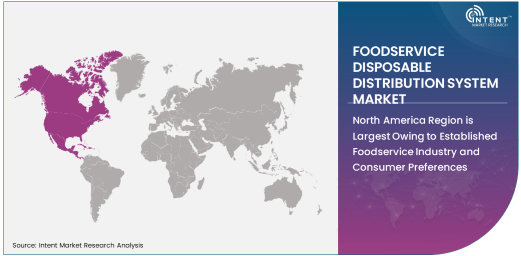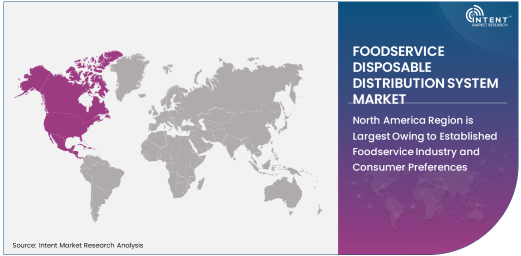As per Intent Market Research, the Foodservice Disposable Distribution System Market was valued at USD 66.2 Billion in 2023 and will surpass USD 113.9 Billion by 2030; growing at a CAGR of 8.1% during 2024 - 2030.
The foodservice disposable distribution system market encompasses the supply and utilization of single-use items such as tableware, packaging, and cutlery within the foodservice industry. This sector has witnessed significant growth, driven by the increasing demand for convenience, hygiene, and cost-effectiveness in dining establishments.
Tableware Disposables Segment is Largest Owing to High Demand in Diverse Foodservice Settings
This dominance is attributed to the widespread use of disposable plates, bowls, and trays across restaurants, fast-food outlets, and catering services. The convenience and hygiene offered by single-use tableware make it a preferred choice for establishments aiming to provide quick and sanitary dining experiences. Additionally, the growing trend of takeout and delivery services has further bolstered the demand for disposable tableware, as it facilitates easy packaging and consumption.

Plastic Material is Fastest Growing Owing to Versatility and Cost-Effectiveness
In terms of material, plastic disposables are experiencing the fastest growth within the foodservice distribution system market. Plastic items, including cutlery, cups, and containers, are favored for their durability, versatility, and cost-effectiveness. They are lightweight, resistant to breakage, and suitable for a wide range of food and beverage applications. The affordability and availability of plastic disposables have made them a staple in the foodservice industry, catering to both high-end restaurants and fast-food chains. However, the environmental impact of plastic waste is prompting a shift towards more sustainable alternatives, influencing future market dynamics.
Restaurants End-Use Segment is Largest Owing to High Volume of Disposable Usage
The restaurant sector stands as the largest end-user of disposable distribution systems, driven by the high volume of disposable items required to serve customers efficiently. Restaurants utilize a vast array of disposable products, including tableware, packaging, and cutlery, to meet the needs of dine-in, takeout, and delivery services. The fast-paced nature of the restaurant industry necessitates the use of disposables to maintain operational efficiency and hygiene standards. The convenience and cost-effectiveness of disposable items align with the operational requirements of restaurants, reinforcing their dominant position in the market.
North America Region is Largest Owing to Established Foodservice Industry and Consumer Preferences
Geographically, North America leads the foodservice disposable distribution system market, attributed to its well-established foodservice industry and consumer preferences for convenience. The United States, in particular, has a mature market with a high density of restaurants, fast-food outlets, and catering services that extensively use disposable items. The prevalence of on-the-go dining and delivery services in urban areas further drives the demand for disposables. Additionally, the region's focus on hygiene and food safety standards contributes to the widespread adoption of disposable distribution systems in foodservice establishments.

Competitive Landscape and Leading Companies
The foodservice disposable distribution system market is characterized by the presence of several key players striving to meet the evolving demands of the foodservice industry. Leading companies include Party & Paper Solutions Ltd, EFG Foodservice, and MBS Wholesale Ltd. These companies offer a diverse range of disposable products tailored to various foodservice applications. The competitive landscape is marked by continuous innovation, with companies focusing on developing eco-friendly and sustainable disposable solutions to address environmental concerns. Strategic partnerships, mergers, and acquisitions are common as companies aim to expand their market presence and product offerings. The emphasis on sustainability and regulatory compliance is shaping the competitive dynamics of the market, influencing product development and market strategies.
Recent Developments:
- Dart Container Corporation acquired Solo Cup Company, enhancing its product offerings and strengthening its position in the disposable foodservice market.
- Huhtamaki Group launched a new line of biodegradable foodservice packaging solutions, meeting the increasing demand for sustainable and eco-friendly disposables.
- Pactiv Evergreen Inc. invested in expanding its manufacturing facilities, focusing on producing sustainable and environmentally-friendly disposable products for the foodservice industry.
- Berry Global Inc. partnered with leading foodservice chains to introduce eco-friendly disposable products, supporting sustainability goals across the foodservice sector.
- Crown Holdings Inc. received an innovation award for its advancements in the design of disposable foodservice packaging, improving both sustainability and functionality.
List of Leading Companies:
- Berry Global Inc.
- Biopak Pty Ltd
- Crown Holdings Inc.
- Dart Container Corporation
- Eco-Products Inc.
- Genpak LLC
- Georgia-Pacific LLC
- Graphic Packaging International LLC
- Huhtamaki Group
- International Paper Company
- Lollicup USA Inc.
- Pactiv Evergreen Inc.
- Reynolds Consumer Products LLC
- Sabert Corporation
- WinCup Holdings Inc.
Report Scope:
|
Report Features |
Description |
|
Market Size (2023) |
USD 66.2 Billion |
|
Forecasted Value (2030) |
USD 113.9 Billion |
|
CAGR (2024 – 2030) |
8.1% |
|
Base Year for Estimation |
2023 |
|
Historic Year |
2022 |
|
Forecast Period |
2024 – 2030 |
|
Report Coverage |
Market Forecast, Market Dynamics, Competitive Landscape, Recent Developments |
|
Segments Covered |
Foodservice Disposable Distribution System Market by Product Type (Tableware, Packaging, Cutlery), by Material (Plastic, Paper, Biodegradable), by End-Use (Restaurants, Fast Food Outlets, Catering) |
|
Regional Analysis |
North America (US, Canada, Mexico), Europe (Germany, France, UK, Italy, Spain, and Rest of Europe), Asia-Pacific (China, Japan, South Korea, Australia, India, and Rest of Asia-Pacific), Latin America (Brazil, Argentina, and Rest of Latin America), Middle East & Africa (Saudi Arabia, UAE, Rest of Middle East & Africa) |
|
Major Companies |
Berry Global Inc., Biopak Pty Ltd, Crown Holdings Inc., Dart Container Corporation, Eco-Products Inc., Genpak LLC, Graphic Packaging International LLC, Huhtamaki Group, International Paper Company, Lollicup USA Inc., Pactiv Evergreen Inc., Reynolds Consumer Products LLC and WinCup Holdings Inc. |
|
Customization Scope |
Customization for segments, region/country-level will be provided. Moreover, additional customization can be done based on the requirements |
|
1. Introduction |
|
1.1. Market Definition |
|
1.2. Scope of the Study |
|
1.3. Research Assumptions |
|
1.4. Study Limitations |
|
2. Research Methodology |
|
2.1. Research Approach |
|
2.1.1. Top-Down Method |
|
2.1.2. Bottom-Up Method |
|
2.1.3. Factor Impact Analysis |
|
2.2. Insights & Data Collection Process |
|
2.2.1. Secondary Research |
|
2.2.2. Primary Research |
|
2.3. Data Mining Process |
|
2.3.1. Data Analysis |
|
2.3.2. Data Validation and Revalidation |
|
2.3.3. Data Triangulation |
|
3. Executive Summary |
|
3.1. Major Markets & Segments |
|
3.2. Highest Growing Regions and Respective Countries |
|
3.3. Impact of Growth Drivers & Inhibitors |
|
3.4. Regulatory Overview by Country |
|
4. Food & Beverages, by Product Type (Market Size & Forecast: USD Million, 2022 – 2030) |
|
4.1. Tableware |
|
4.2. Packaging |
|
4.3. Cutlery |
|
4.4. Others |
|
5. Food & Beverages, by Material (Market Size & Forecast: USD Million, 2022 – 2030) |
|
5.1. Plastic |
|
5.2. Paper |
|
5.3. Biodegradable |
|
5.4. Others |
|
6. Food & Beverages, by End-Use (Market Size & Forecast: USD Million, 2022 – 2030) |
|
6.1. Restaurants |
|
6.2. Fast Food Outlets |
|
6.3. Catering |
|
6.4. Others |
|
7. Regional Analysis (Market Size & Forecast: USD Million, 2022 – 2030) |
|
7.1. Regional Overview |
|
7.2. North America |
|
7.2.1. Regional Trends & Growth Drivers |
|
7.2.2. Barriers & Challenges |
|
7.2.3. Opportunities |
|
7.2.4. Factor Impact Analysis |
|
7.2.5. Technology Trends |
|
7.2.6. North America Food & Beverages, by Product Type |
|
7.2.7. North America Food & Beverages, by Material |
|
7.2.8. North America Food & Beverages, by End-Use |
|
7.2.9. By Country |
|
7.2.9.1. US |
|
7.2.9.1.1. US Food & Beverages, by Product Type |
|
7.2.9.1.2. US Food & Beverages, by Material |
|
7.2.9.1.3. US Food & Beverages, by End-Use |
|
7.2.9.2. Canada |
|
7.2.9.3. Mexico |
|
*Similar segmentation will be provided for each region and country |
|
7.3. Europe |
|
7.4. Asia-Pacific |
|
7.5. Latin America |
|
7.6. Middle East & Africa |
|
8. Competitive Landscape |
|
8.1. Overview of the Key Players |
|
8.2. Competitive Ecosystem |
|
8.2.1. Level of Fragmentation |
|
8.2.2. Market Consolidation |
|
8.2.3. Product Innovation |
|
8.3. Company Share Analysis |
|
8.4. Company Benchmarking Matrix |
|
8.4.1. Strategic Overview |
|
8.4.2. Product Innovations |
|
8.5. Start-up Ecosystem |
|
8.6. Strategic Competitive Insights/ Customer Imperatives |
|
8.7. ESG Matrix/ Sustainability Matrix |
|
8.8. Manufacturing Network |
|
8.8.1. Locations |
|
8.8.2. Supply Chain and Logistics |
|
8.8.3. Product Flexibility/Customization |
|
8.8.4. Digital Transformation and Connectivity |
|
8.8.5. Environmental and Regulatory Compliance |
|
8.9. Technology Readiness Level Matrix |
|
8.10. Technology Maturity Curve |
|
8.11. Buying Criteria |
|
9. Company Profiles |
|
9.1. Berry Global Inc. |
|
9.1.1. Company Overview |
|
9.1.2. Company Financials |
|
9.1.3. Product/Service Portfolio |
|
9.1.4. Recent Developments |
|
9.1.5. IMR Analysis |
|
*Similar information will be provided for other companies |
|
9.2. Biopak Pty Ltd |
|
9.3. Crown Holdings Inc. |
|
9.4. Dart Container Corporation |
|
9.5. Eco-Products Inc. |
|
9.6. Genpak LLC |
|
9.7. Georgia-Pacific LLC |
|
9.8. Graphic Packaging International LLC |
|
9.9. Huhtamaki Group |
|
9.10. International Paper Company |
|
9.11. Lollicup USA Inc. |
|
9.12. Pactiv Evergreen Inc. |
|
9.13. Reynolds Consumer Products LLC |
|
9.14. Sabert Corporation |
|
9.15. WinCup Holdings Inc. |
|
10. Appendix |
A comprehensive market research approach was employed to gather and analyze data on the Foodservice Disposable Distribution System Market. In the process, the analysis was also done to analyze the parent market and relevant adjacencies to measure the impact of them on the Foodservice Disposable Distribution System Market. The research methodology encompassed both secondary and primary research techniques, ensuring the accuracy and credibility of the findings.
.jpg)
Secondary Research
Secondary research involved a thorough review of pertinent industry reports, journals, articles, and publications. Additionally, annual reports, press releases, and investor presentations of industry players were scrutinized to gain insights into their market positioning and strategies.
Primary Research
Primary research involved conducting in-depth interviews with industry experts, stakeholders, and market participants across the E-Waste Management ecosystem. The primary research objectives included:
- Validating findings and assumptions derived from secondary research
- Gathering qualitative and quantitative data on market trends, drivers, and challenges
- Understanding the demand-side dynamics, encompassing end-users, component manufacturers, facility providers, and service providers
- Assessing the supply-side landscape, including technological advancements and recent developments
Market Size Assessment
A combination of top-down and bottom-up approaches was utilized to analyze the overall size of the Foodservice Disposable Distribution System Market. These methods were also employed to assess the size of various subsegments within the market. The market size assessment methodology encompassed the following steps:
- Identification of key industry players and relevant revenues through extensive secondary research
- Determination of the industry's supply chain and market size, in terms of value, through primary and secondary research processes
- Calculation of percentage shares, splits, and breakdowns using secondary sources and verification through primary sources
.jpg)
Data Triangulation
To ensure the accuracy and reliability of the market size, data triangulation was implemented. This involved cross-referencing data from various sources, including demand and supply side factors, market trends, and expert opinions. Additionally, top-down and bottom-up approaches were employed to validate the market size assessment.
NA
